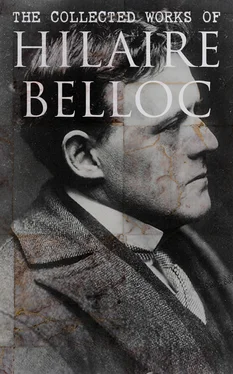On the eastern side of the Park it is continued for about 200 yards as a footpath. It is then lost under the plough; but a lane, some seven furlongs further on to the east, recovers the alignment, 34and leads straight on to the crossing of the Darent, down just such a spur as marked the crossing of the Mole, while above us went a flanking road, marked by stunted trees, on the windy edge of the Downs.
Following it thus we passed the northernmost of the two railway arches, went down the hill a mile or so, crossed the plain that was till recently marshy and difficult, and entered the village of Otford by the bridge and over the ford whereby, certainly since Edmund Ironside, and probably for many thousands of years before that, men had come to it.
Indeed, here, where the Old Road falls into the valley of the Darent, its importance in recorded history, which had been growing steadily as we went eastward, was suddenly increased for us, and the cause was the reception at this point of its tributary from London. From Otford the Old Road becomes strategic. It is the road by which marched the defending forces when invasion was threatened from the Thames estuary. It becomes hierarchic; the power of Canterbury seizes it; and it becomes royal, perpetually recalling the names and at last the tyranny of the kings. The battle against the invader, the king's progress to the sea, the hold of the Church upon the land it traverses, fill all the final marches from the crossing of the Darent to that of the Stour. Something of military history as at Alton, at Farnham, and just down the Stane Street at Anstie Bury, had attached even to the earlier part of so ancient a way—but from Otford onward it is greatly emphasised.
As one comes down from the chalk pit above the river one is crossing what is probably the site of Edmund Ironside's great and successful struggle with the Danes in 1016, when he defeated Canute and drove him across the river, and pursued the rout mile upon mile to Aylesford. Half a mile further down on the plain, just before you get into the village, is the field where Offa is said to have achieved the supremacy of England by the conquest of Kent in 773.
It is only a doubtful bit of tradition, but it is worth recording that one more battle was fought here—as the populace believed—in the very first struggle of all—in the legendary fifth century. It is said that the Saxons were defeated here by the British, and that they also retreated towards Aylesford.
Canterbury had shown its influence long before this valley. We had seen the chapels and had but just left Brasted, whose allegiance to the archbishop was old beyond all record. But from Otford onward the power of the See became peculiar and more definite.
First there was the string of great palaces, Otford, Wrotham, Maidstone, Charing: Otford, Wrotham, and Charing especially, standing as they did directly upon the Old Road and created by it. We saw them all. They are in ruins.
Their authority, their meaning, had been suddenly destroyed. No one had claimed or supported their enormous walls. The new landlords of the Reformation, the swarm, the Cecils and the Russells and the rest, seem for once to have felt some breath of awe. The palaces were permitted to die. I imagined as I saw them one by one that the few stones remaining preserved a certain amplitude and magnificence; it may have been nothing but the fantasy of one who saw them thus for the first time, his mind already held for so many days by the antiquity of the Road.
They are forgotten. They were great for their time. Their life was intense. The economic power of the throne and of the chief altar in England ran through them. Otford at Domesday had its hundred small farms, its six mills; it was twice the size of Westerham. Wrotham and Charing, somewhat less, were yet (with Maidstone) the chief centres of Kent south of the Downs.
And apart from the See the Church in general held all the line. At Boxley, eldest daughter of Waverley, Clairvaux and the spirit of St. Bernard showed; it became as great as the palaces. Hollingbourne, fifty years before the Conquest, had been granted to St. Augustine's, a hundred years before that Lenham to Christchurch. The connection of Charing with Canterbury was so old that men believed their 'Vortigern' to have dedicated its land, and the church could show, even of writing, a parchment older than Alfred by a hundred years.
All these things had gone as utterly as the power to build and to think and to take joy in the ancient manner; the country-side we were treading held their principal and silent memorials.
For upon all this—which was England and the people—had fallen first the crown and then the rich, but the crown had begun the devastation.
I have said that from Otford the Old Road becomes royal, for it is at Otford that the road from Greenwich, after following the valley of the Darent, falls into the Pilgrim's Way. From Westminster by water to Greenwich, from Greenwich down here to Otford, and thence along the Old Road to the sea, had been a kind of sacred way, for the kings, who used as they went the great palaces of the Archbishops for their resting-places. By this road, last of so many, went Henry VIII. to the Field of the Cloth of Gold. It was an alternative to the straight road by Watling Street, and an alternative preferred from its age and dignity.
Then came its ruin. The grip of the crown caught up all the string of towns and villages and palaces and abbeys. You see the fatal date, '20th November, 29th Henry VIII.' recurring time and time again. Otford is seized, Wrotham is seized, Boxley, Hollingbourne, Lenham, Charing, and with these six great bases, a hundred detached and smaller things: barns, fields, mills, cells—all the way along this wonderful lane the memory of the catastrophe is scarred over the history of the country-side like the old mark of a wound, till you get to poor Canterbury itself and find it empty, with nothing but antiquarian guesses to tell you of what happened to the shrine and the bones of St. Thomas.
The Holy Well at Otford, its twin at Burham, the rood of Boxley, the block of Charing were trampled under. The common people, first apathetic, then troubled—lastly bereft of religion, lost even the memory of the strong common life as the old men died; sites which had been sacred ever since men had put up the stones of Addington or Trottescliffe, or worshipped Mithra on the bank of the Medway, or put the three monoliths of Kit's Coty House together to commemorate their chief, or raised the hundred stones—all these were utterly forgotten.
It was not enough in this revolution that the Church should perish. The private lands of the most subservient were not safe—Kemsing, for example. It was the Manor of Anne Boleyn's father: it may be imagined what happened to such land. I know of no district in England where the heavy, gross, and tortured face of Henry in his decline haunts one more. Sacredness is twofold—of pleasure and pain—and this, the sacred end of our oldest travel, suffered in proportion to its sanctity.
* * * * *
When we had passed the Darent at Otford and climbed the hill beyond, we came upon a section of the road which might be taken as a kind of model of its character along these hills.
It is a section six miles long, beginning upon the hillside just above Otford station and ending near the schoolhouse above Wrotham. But in this short distance it gives examples of nearly all the points which it is the business of this book to describe. There is indeed no part of it here which requires to be sought out and mapped. The whole is known and has a continuous history; and such certitude is the more valuable in a typical division, because it permits us to deduce much that can elsewhere be applied to the less known portions of the road.
The Old Road runs here (as throughout nearly the whole of its course between Dorking and Canterbury) up on the bare hillside above the valley. The road appears, as one walks it, to run at the same level all along the hillside, but really it is rising as the floor of the valley rises, in order to keep continuously at the same distance above it. Its lowest point is not much under 300 feet, but its highest is just over 500.
Читать дальше












